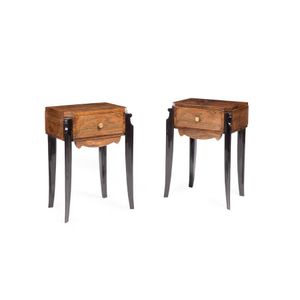French Wood Bedside Tables, Circa 1925
You must be a subscriber, and be logged in to view price and dealer details.
Subscribe Now to view actual auction price for this item
When you subscribe, you have the option of setting the currency in which to display prices to $Au, $US, $NZ or Stg.
- Mahogany - Mahogany is a dense, close grained red-coloured timber from the West Indies and Central America. It was first imported into Europe in the the early 18th century and its use continued through the 19th century. It was popular for furniture making because of its strength, the wide boards available, the distinctive grain on some boards, termed flame mahogany and the rich warm colour of the timber when it was polished.. The "flame" was produced where a limb grew out from the trunk of the tree, and this timber was usually sliced into veneers for feature panels on doors, backs and cornices.
Some terms used to describe mahogany relate to the country from which it originally came, such as "Cuban" mahogany, "Honduras" mahogany etc. However unless the wood has been tested the names assigned are more a selling feature, rather than a true indication of the timber's origin. - Circa - A Latin term meaning 'about', often used in the antique trade to give an approximate date for the piece, usually considered to be five years on either side of the circa year. Thus, circa 1900 means the piece was made about 1900, probably between 1895 and 1905. The expression is sometimes abbreviated to c.1900.
- Rosewood - A dense timber that varies in shade to very light brown to almost black. When rosewood is cut and sanded the colour of the timber will turn black, and after polishing and exposure to daylight, the surface will gradually lighten over time to light brown with black streaks.
The name comes from the odour emanating from the timber when it is planed, sanded or cut.
Rosewood was very popular for use in Victorian furniture in the second half of the 19th century, and at that time most of the rosewood was imported from Brazil. However it also grows in India and Indonesia.
It is used in the sold for chairs and table legs, but for carcase furniture such as side cabinets and bookcases, and for table tops it is always used as a veneer. - Ebonised - Timber that has been stained or lacquered black in imitation of ebony. The process has been used since the Renaissance, but is most commonly found in late 19th century furniture, sometimes gilded and turned in imitation of bamboo. Furniture with an ebonised finish is not currently in vogue, and this is reflected in the price for such pieces.
This item has been included into following indexes:
- Anglo-Indian - furniture, tables 74
- bedside cabinets and tables, French - French 260
- bedside cabinets and tables, timber
Visually similar items

A George III rosewood and satinwood banded card table, with ebony and boxwood banding and panels throughout, the fold over rectangular top with rounded corners and later green baize, on four square tapering legs, the two rear supports hinged to support the

A George III mahogany extension dining table with extensions, English, early 19th century, 73 cm high, 285 cm wide and 121 cm deep

A George III mahogany D-end extension dining table, circa 1780 Three leaves, 75 cm high, 262 cm wide and 107 cm deep

Goldfields kitchen table possibly Chinese maker, eucalypt and pine, Bendigo area Victoria, 19th century 75 cm high, 165 cm wide, 73 cm deep
